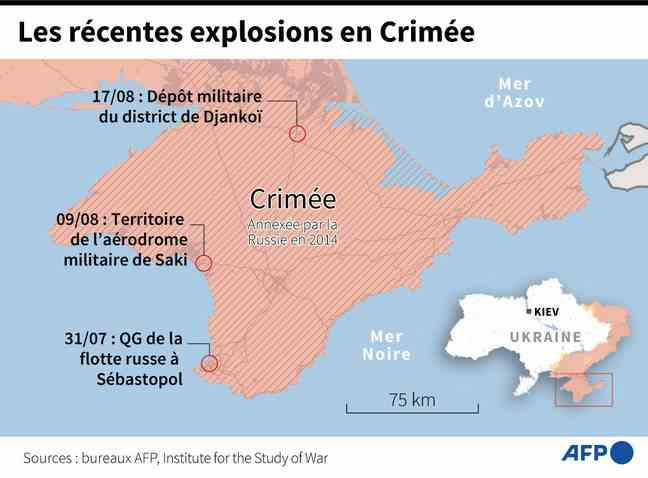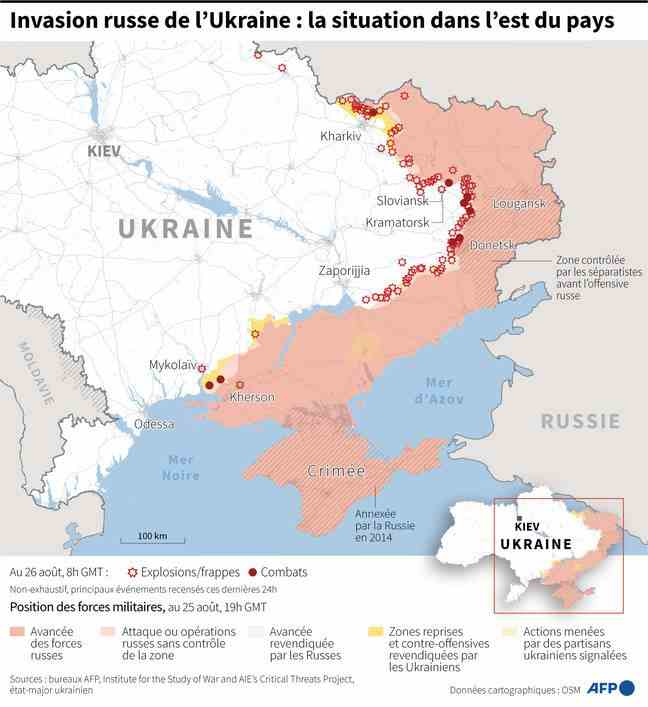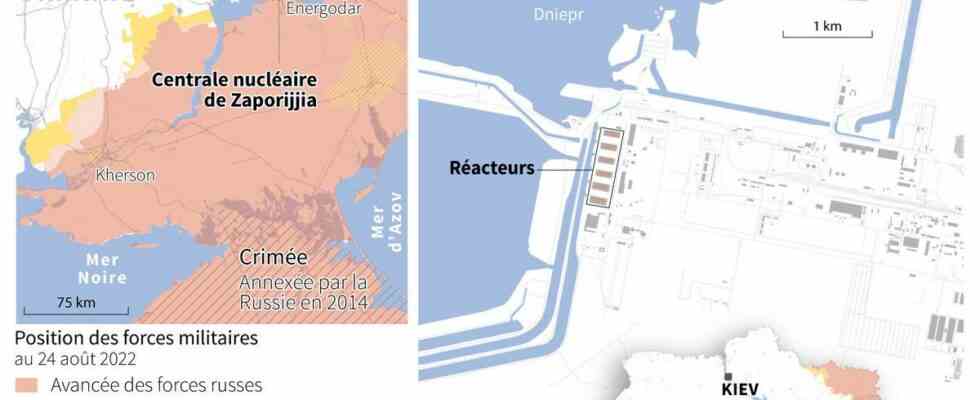Another week of war in Ukraine. A week marked by this August 24, Independence Day, which commemorates the separation from the USSR in 1991. A symbolic Wednesday which also brought kyiv into its seventh month of the Russian invasion, launched on February 24. And if, this week, the renewed support of Western leaders for Ukraine, Tuesday during the summit of the “Crimean platform” or the Daria Douguina affair have marked the spirits, it is still the nuclear power plant of Zaporozhye which has concentrated tensions, calls for calm, attacks and “fake news”. With her, the Crimea, still a center of interest, but also the village of Tchapliné or, in the East, the demotivated pro-Russians. Here is a point in four infographics on this new week of war in Ukraine, ending this Friday, the 183rd day of conflict.
Zaporozhye, at the heart of the conflict
For weeks, Moscow and kyiv have accused each other of several bombings that targeted the site of the gigantic Zaporozhye nuclear power plant, raising fears of a nuclear disaster. The UN has called for the establishment of a demilitarized zone around the plant to guarantee the safety of its six reactors with a capacity of 1,000 megawatts each.
However, tensions rose a notch further this week when the power station, the largest in Europe, which fell into Russian hands in March, was completely disconnected on Thursday (“for the first time in its history”). The next day, this Friday morning, kyiv announced that it was preparing to connect to the electricity network. According to Energoatom, the Ukrainian public operator of the country’s four atomic power plants, a line delivering electricity produced by the plant to the Ukrainian energy network “has been repaired”. The perpetually bombed plant is currently supplied via another repaired line from the Ukrainian electricity network, the operator said, while ensuring that the equipment and security systems of this installation were functioning normally.
The devastated village of Tchapliné

Several Russian missiles fell Wednesday afternoon on the village of Chapliné, a town of 4,000 people and a railway hub in the Dnipropetrovsk region (central-eastern Ukraine). The strike killed at least 25 people, including two children, and injured 31, according to the latest report announced Thursday by kyiv. The attack hit the station and “five carriages caught fire,” said Artem Jouravliov, a local official of the state emergency service. The Ukrainian railway company reported three of its employees killed and four others injured and published photos of charred passenger cars.
For its part, Moscow claimed to have hit “a military train” bound for “combat zones” in eastern Ukraine, Moscow’s priority strategic objective. An Iskander missile “directly hit a military train at Chapliné station (…) eliminating more than 200 servicemen from the Ukrainian Armed Forces reserve” as well as equipment, the Russian Defense Ministry said.
The counter-offensive in Crimea

For several weeks, Ukrainian forces have been carrying out a counter-offensive in the south of the country. Explosions of undetermined origin – long-range strikes or sabotage according to experts – thus damaged a military airfield and a Russian ammunition depot in Crimea. A Crimea which remains at the forefront of the military offensive led by Russia against its Ukrainian neighbor.
It serves as a logistics rear base for the Russian forces. Planes from Moscow take off there almost daily to strike targets in regions under the control of kyiv and several areas of this peninsula are located within the range of Ukrainian guns and drones. The offensive on southern Ukraine which enabled Moscow to capture large swaths of territory in the first weeks of the war thus started in Crimea.
Attacks on Russian positions in Crimea “likely part of a cohesive Ukrainian counter-offensive aimed at regaining control of the western bank of the Dnieper”, observed this week the North American Institute for the Study of War (ISW). The forces of kyiv, which also fired on the bridges spanning this river, seek to prevent the supply and the reinforcement of the Russian troops present west of the Dnieper, in particular in the region of Kherson, he continues.
More than six months of land, without end

Since the withdrawal of Russian forces from around the Ukrainian capital at the end of March, the bulk of the fighting has been concentrated in the east, where Moscow has slowly gained ground before the front froze. And after six months of guerrilla warfare, part of the pro-Russian militia of the “Republic” of Lugansk (LNR), which makes up the Donbass with that of Donetsk (DNR), refuses to fight in the DNR, estimates the North- American on the Study of War (ISW). “The soldiers claim to have celebrated the victory on July 3, when the LNR forces reached the borders of Lugansk, and their work was finished”, specifies the American research center, which assures that this is part of a ” broader trend of decreasing investment” by pro-Russian militias. Part of the DNR troops had complained in a similar way in recent months when they had been reassigned to the Lugansk region or to Kherson (south), notes the ISW.
The fact remains that this Tuesday, the United States Embassy in kyiv broadcast an alarmist message in the morning warning that Russia could bombard the East even more “in the coming days” and recommended that American citizens leave “now”. the country.

